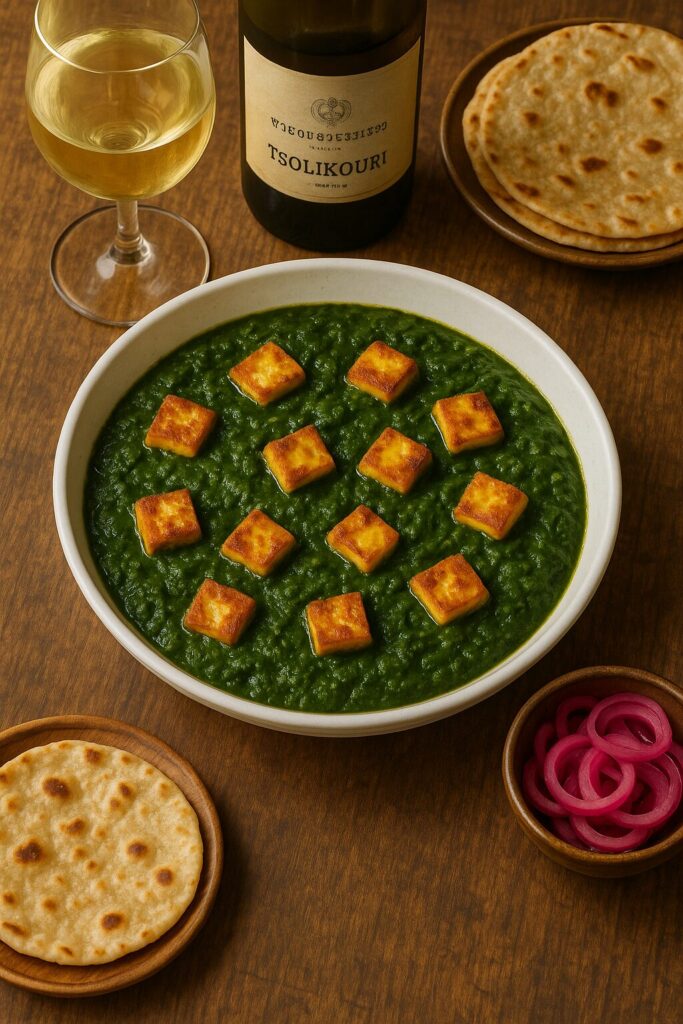5 min read
Introduction
Saag Paneer, a beloved vegetarian dish from the Indian subcontinent, is a celebration of creamy textures, earthy greens, and gentle spices. Rich in tradition and flavor, this dish may not seem like an obvious candidate for wine pairing—but with a thoughtful approach, it opens up a vibrant world of sensory delight.
Saag Paneer & Cultural Context
A staple in North Indian kitchens, Saag Paneer blends puréed leafy greens—typically mustard greens, spinach, or a mix—with aromatic spices and cubes of soft, fresh paneer (a non-melting Indian cheese). Eaten with flatbreads like roti or makki di roti, it is deeply associated with Punjabi cuisine, especially during the winter harvest festival Lohri.
Key Ingredients & Preparation Style
- Leafy greens: Mustard greens (sarson), spinach, fenugreek, or collards
- Paneer: Fresh Indian cheese with a neutral, milky flavor
- Spices: Ginger, garlic, cumin, garam masala, turmeric, green chili
- Finish: Often tempered with ghee or butter for richness
Saag Paneer is slow-cooked and often puréed to achieve a creamy, textured dish where spices meld into the greens rather than dominate them.
Flavor & Texture Profile
- Texture: Creamy, soft, slightly fibrous greens with chewy paneer
- Dominant Flavors: Earthy, vegetal, subtly bitter, warm spice
- Heat: Mild to medium, depending on chili levels
- Umami: From ghee, garlic, and slow-cooked greens
Science Behind Spice & Wine Interactions
Key Wine Principles:
- Acidity: Balances the richness of ghee and paneer.
- Sweetness: Helps counter mild heat.
- Low Tannins: Prevent clashing with bitter greens or spice.
- Aromatic Whites & Light Reds: Complement earthy, green notes.
Spice Compounds to Watch:
- Piperine (from black pepper) and capsaicin (from chilies) interact poorly with high alcohol or tannins.
- Sulfur compounds from greens demand fresh, clean wines to avoid vegetal overload.
Ideal Wine Pairings: Science & Art of Selection
White Wines
1. Tsolikouri (Imereti, Georgia)
Why it Works: This Georgian white offers stone fruit notes, medium acidity, and a waxy mouthfeel that complements the creaminess of saag without overpowering it.
Regions/Producers to Try: Baia’s Wine, DoReMi, Nikoladzeebis Marani
2. Grüner Veltliner (Austria)
Why it Works: Bright acidity and herbal notes mirror the green flavors, while white pepper hints echo Indian spice.
Regions/Producers to Try: Weingut Bründlmayer, Domäne Wachau
3. Viognier (France or California)
Why it Works: Lush texture aligns with the saag, while stone fruit and floral aromatics elevate the earthy tones.
Regions/Producers to Try: Yalumba (Australia), Darioush (Napa), E. Guigal (Condrieu)
Red Wines
1. Zweigelt (Austria)
Why it Works: Juicy red fruit, low tannin, and herbal complexity create a gentle contrast without clashing.
Regions/Producers to Try: Heinrich, Umathum, Loimer
2. Frappato (Sicily, Italy)
Why it Works: Delicate structure, floral nose, and red cherry notes lift the dish and complement its creamy base.
Regions/Producers to Try: COS, Occhipinti
3. Gamay (Beaujolais, France)
Why it Works: Fresh acidity and vibrant red fruit bring brightness to the dish, while its low tannins are spice-friendly.
Regions/Producers to Try: Domaine Lapierre, Jean Foillard, Château Thivin
Alternate Wines: Unexpected Pairings
Orange Wines (Skin-Contact Whites)
Why it Works: Their textural grip and savory complexity align beautifully with the green bitterness of saag and the density of paneer.
- Try: Rkatsiteli Qvevri from Georgia—amber in color, tea-like tannins, and earthy nuances match saag’s depth.
Sparkling Rosé
Why it Works: The effervescence cuts through richness, while the berry profile plays with the dish’s subtle warmth and spices.
- Try: Crémant de Loire Rosé or a Brut Nature Rosé Cava
Wines to Avoid & Common Mistakes
What to Skip:
- Big, oaky Chardonnays: Too heavy, cloying with spice and ghee.
- Tannic reds (Cabernet Sauvignon, Syrah): Clash with bitterness and intensify spice.
- High-alcohol wines: Amplify heat and overwhelm delicate greens.
Common Mistakes:
- Matching weight without considering bitterness
- Overpowering subtle vegetal tones with strong fruit bombs
- Choosing “sweet” wines assuming all Indian food is spicy
Quick-Reference Table
| Mismatched Pairing | Why It Doesn’t Work | Better Alternative | Example Wine | Example Reason | Suggested Wine |
|---|---|---|---|---|---|
| Oaked Chardonnay | Clashes with ghee & vegetal bitterness | Tsolikouri | Kendall-Jackson VR | Too rich, lacks acidity | Baia’s Wine Tsolikouri |
| Cabernet Sauvignon | Tannins + spice = unpleasant heat | Gamay | Caymus | Overwhelms dish | Domaine Lapierre Gamay |
| Gewürztraminer (off-dry) | Too floral, clashes with savory greens | Grüner Veltliner | Trimbach Gewürztraminer | Mismatch with umami bitterness | Domäne Wachau Grüner |
Final Thoughts & Expert Tips
Saag Paneer is a dish that rewards nuance in wine pairing. Don’t overwhelm it—listen to its earthy softness, its gentle heat, its quiet depth. Seek out wines that reflect those elements with finesse rather than force.
Fun Fact: In Georgia, traditional wines like Tsolikouri are often made in clay vessels called qvevri buried underground—an ancient method that beautifully matches the rustic, traditional preparation of saag.
Personal Tip: A glass of orange Rkatsiteli with saag and hot roti by the fireplace in winter? Pure joy.
Recipe & Wine-Friendly Adjustments
Ingredients
- 1 bunch mustard greens
- 1 bunch spinach
- 1 block paneer (cubed)
- 2 tbsp ghee
- 1 small onion, chopped
- 1-inch ginger, minced
- 4 garlic cloves, minced
- 1 green chili, sliced
- ½ tsp turmeric
- ½ tsp cumin seeds
- Salt, to taste
- Water or stock (as needed)
Preparation
- Wash and chop greens. Boil until wilted and tender, then purée.
- In a pan, heat ghee. Add cumin, onions, garlic, ginger, and chili.
- Sauté till golden, then add turmeric and the puréed greens. Simmer 10–15 mins.
- In a separate pan, sear paneer cubes until golden.
- Mix paneer into greens. Adjust salt and serve hot.
Wine-Friendly Modifications
- Reduce chili for better balance with delicate wines.
- Use olive oil instead of ghee if you prefer lighter pairings.
- Add lemon juice or yogurt for acidity—helps with crisp white wines.
Serving Suggestions
- Plate with makki di roti, drizzle with ghee or butter.
- Add radish salad or pickled onions for brightness.
- Serve with wine in a chilled tulip glass (for whites or orange wines) or a universal stem.


